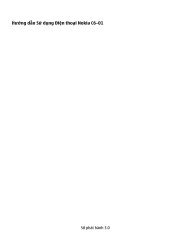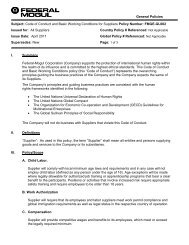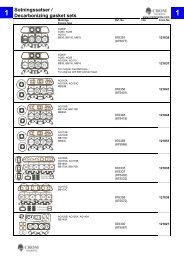Create successful ePaper yourself
Turn your PDF publications into a flip-book with our unique Google optimized e-Paper software.
A<br />
ENGINEERING<br />
The unique design of a tapered roller bearing with its line contact<br />
produces a damping characteristic that is not necessarily inherent<br />
to other bearing designs (Figure 31). This is due to the bending<br />
mode of the spindle and bearing centerline caused by dynamic<br />
deflection which is resisted inside the bearing through a shearing<br />
action of the viscous lubricant between the rollers and the cup<br />
and cone races.<br />
It is the combination of the tapered roller bearing construction<br />
and proper bearing setting that results in improved damping<br />
characteristics.<br />
Fig. 31. Damping in a tapered roller bearing.<br />
An extension of this insight culminated in the development of a<br />
bearing system called the Hydra-Rib. It is, specifically designed to<br />
provide the optimum bearing preload and thus the ultimate dynamic<br />
stability <strong>for</strong> the spindle system under any operating conditions.<br />
Proper selection of the preload <strong>for</strong> a given application must not focus<br />
only on stiffness and damping characteristics. Also, the lubrication<br />
method, operating speeds and loads must be reviewed to determine<br />
the optimum setting/preload to maximize per<strong>for</strong>mance. Consult the<br />
appropriate topic in this engineering section <strong>for</strong> more details.<br />
OTHER FACTORS AFFECTING<br />
BEARING SELECTION<br />
Some additional controllable factors having a significant impact<br />
on bearing per<strong>for</strong>mance include mounting fits, internal clearances,<br />
lubricant type and integrity. For example, when using radial ball<br />
bearings, appropriate internal clearance is needed to ensure<br />
proper operation.<br />
THERMAL EXPANSION<br />
Issues such as axial displacement must be addressed where shaft<br />
length differentials must be tolerated when thermal expansion<br />
occurs. For these situations, the rotating component supports<br />
include a fixed (locating) and floating (non-locating) bearing<br />
arrangement.<br />
The fixed bearing is subject to combination loads and is usually<br />
placed nearest the working end of the shaft to minimize motion and<br />
thereby maintain workpiece accuracy. Installation considerations<br />
<strong>for</strong> the typical fixed bearing positions should note the fitting<br />
suggestions listed in this catalog. These are compiled from a wealth<br />
of experience in a wide range of operating conditions.<br />
Where floating bearings are necessary, the design must allow<br />
<strong>for</strong> axial displacement of the shaft. This can be accomplished by<br />
allowing the bearing to “slide” laterally along the shaft or housing<br />
respectively. A looser fit during the machining of the shaft or housing<br />
cavity is required. This not only alleviates the axial stresses on<br />
this end of the assembly, but will also facilitate bearing and shaft<br />
installation.<br />
MISALIGNMENT<br />
When the size of the machine increases, so do concerns about<br />
alignment. Shaft bending or additional loading can impart moment<br />
loads that need to be considered. Bearing selection must further<br />
consider installation practices with distant machined bearing<br />
housing cavities. Manufacturing limitations to position housing<br />
bores might encourage the choice of a self-aligning bearing<br />
mounting (DF, face-to-face).<br />
This can help compensate <strong>for</strong> machining variations and assist in<br />
managing dynamic <strong>for</strong>ces by featuring a spherical outside diameter<br />
or thrust face.<br />
Duplex - DF<br />
Face-to-Face<br />
Duplex<br />
Direct Mounting<br />
Fig. 32. Self-aligning bearing mountings.<br />
34 TIMKEN MACHINE TOOL CATALOG







